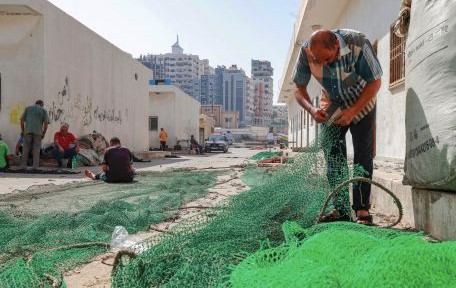Since the beginning of 2019, Israel has shifted its demarcation of the maritime zone open to fishermen in the Gaza Strip 20 times. On nine of these occasions, Israel reduced the fishing zone; in four instances it banned Palestinian fishermen from accessing the sea altogether.
On December 24, Israel reversed its decision from five days earlier, December 19, to reduce the “fishing zone” it enforces in Gaza’s sea space to a maximum distance of 10 nautical miles off shore. As a result, the zone where Israel allows fishing reverted to a maximum of 15 nautical miles off shore in the southern section of the Strip, but up to no more than six nautical miles opposite Gaza City.
The 15 nautical mile limit (about 28 kilometers) was established only in April of 2019, this being the first time this increased distance was opened since Israel began restricting access to Gaza’s territorial waters. However, it is significantly less than the 20 nautical miles (about 37 kilometers) off the coast of Gaza that Palestinians should be allowed to access as specified in the never-fulfilled Israeli-Palestinian Interim Agreement of 1995. Furthermore, Israel only allows large fishing boats to access the area of the zone extending between 12 and 15 nautical miles off the Gaza shore, meaning that only about 10 percent of the fishing vessels currently in working condition in the Palestinian coastal enclave can access that part of the zone.
Despite the repeated changes to the demarcation of the zone, fishermen in Gaza report that 2019 witnessed a rise in the quantity of the catch, indicating the potential for growth in this important economic and nutritional sector if Israel were to remove additional restrictions. According to figures published by the Ministry of Agriculture in Gaza and the United Nations Food and Agriculture Organization, the catch of fish in the first 11 months of 2019 was the largest since the United Nations began monitoring it: a total of 3,472 tons, representing an increase of 19 percent compared to the catch during the corresponding period in 2018.
Though the income of some fishermen increased slightly in 2019, the fishing sector in Gaza still struggles under the closure imposed by Israel on the Strip. Ongoing restrictions on the entrance of certain types of equipment, spare parts and boat engines into the Strip delay maintenance and repairs to fishing boats. According to the United Nations, the number of people making a living from fishing in Gaza has dropped from approximately 10,000 in 2000 to about 3,600 registered fishermen today (of which, only about 2,000 actually engage regularly in fishing).
Israel’s repeated reductions to the permitted fishing zone opposite the Gaza Strip, often in response to rocket fire towards Israel – that no one claims has anything to do with fishermen – constitute collective punishment, illegal under international law, and put peoples’ lives at risk. Israel’s means of enforcing its restrictions to accessing the sea by Palestinian fishermen – firing live ammunition, arresting and detaining fishermen, and seizing their boats and equipment, even when they are well within the permitted zone – has made fishing in Gaza an extremely dangerous occupation.



